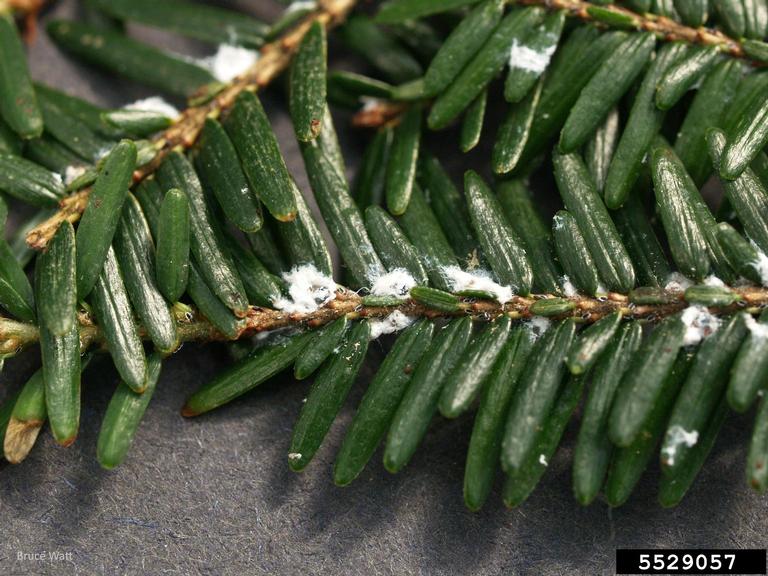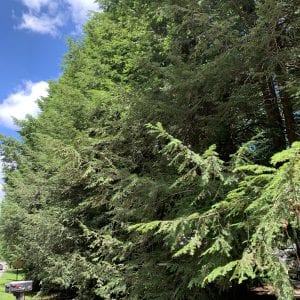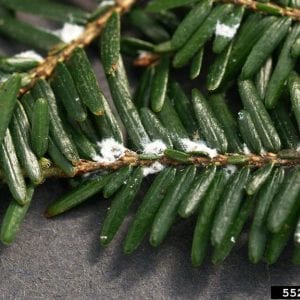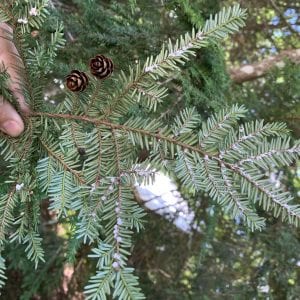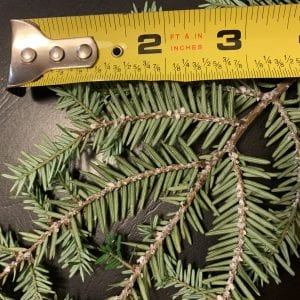Forestry

The hemlock woolly adelgid (HWA), Adelges tsugae, is a nonnative, invasive insect pest that colonizes, feeds on the sap of, and ultimately kills both eastern and Carolina hemlock trees, Tsuga canadensis and Tsuga caroliniana. HWA is native to Japan and was first discovered in Virginia in 1951. However, they were not documented in Alabama until June of 2020 in Mentone, Dekalb County.
Introduction
Hemlock trees are not a widespread species in Alabama, only naturally occurring in the Appalachian foothills of northeastern Alabama and parts of the Bankhead National Forest. As a result, hemlock has little economic importance in terms of timber production in the state, however, it can have great aesthetic value in the landscape as an ornamental evergreen and is highly valued for plant and wildlife diversity where they naturally occur (figure 1). Identification and control of this pest in the landscape is important because untreated hemlock trees are susceptible to infestation and will result in tree death. Past studies have found that HWA can kill or severely damage more than 95 percent of untreated hemlock trees.
- Figure 1. Hemlock trees are an evergreen found throughout the Appalachian Mountains and also planted in the landscape. Here, several mature (and HWA infected) hemlock trees that are of high aesthetic and ornamental value serve as a screen between a home and roadway.
- Figure 2. The topside of this hemlock branch contains the small, white, wool-like eggs sacks and adult coverings of the HWA. Adults themselves are just 1/16 inch in size and difficult to see. Photo courtesy of Bruce Watt, University of Maine, Bugwood.org.
Identification
Hemlock trees are easily identified by their small round cones and short, 1⁄2-inch long, flat needles. Signs of infestation by the HWA include small, 1/16-inch, white, wool- or cotton-like, egg masses and waxy excretions produced by the insect (figure 2). These structures give the pest its namesake and are the most identifiable indicators of their presence. The woolly structures most often occur at the base and underside of the needles, and on the stem itself.
Initial symptoms of the HWA infestation include declining trees, poor growth, branches with thin or light-colored (yellow or gray) needles and significant needle loss. After initial infestations, hemlocks can take anywhere from 4 to 10 years to die. Damaged or heavily infested hemlocks can recover from HWA if treated. Although trees that show severe decline to the point of branch loss and yellowing or graying needles may never fully recover because of the trees’ inability to fully translocate and distribute the insecticide through heavily damaged tissues.
Control
While there are foliar and biological control methods, the most successful treatments for prevention and control of HWA in landscapes are insecticide applications with the active ingredients imidacloprid and dinotefuran by soil injection, soil drench, and basal trunk spray (table 1). These pesticides are systemic neonicotinoids that move through the tree sap and provide long-term control of many insect pests. Southeastern studies have shown imidacloprid applications to be effective on average of 3 to 5 years and even up to 7. Because the rates of spread of HWA can vary, applications should only be made once it has been documented locally or the tree has shown signs of infestation.
Table 1. Brands, Rates, and Notes for Imidacloprid and Dinotefuran Products for HWA Control
*This list is not intended to recommend or endorse specific pesticide brands. Other trade names and concentrations of these compounds may be available. Pesticide labels change often; read and follow the label.
**Diameter at breast height (D.B.H.) is measured 4.5 feet up from the ground.
| Active Ingredient (a.i.) | Brand, Percent a.i.* | Soil Injection/ Drench Rate** | Basal Trunk Spray Rate** | Notes |
|---|---|---|---|---|
| Imidacloprid | Bandit 2F, ImidiPro, Merit 2F, Zenith 2F, 21.4% | 0.1–0.2 oz. per inch of trunk diameter at breast height | n/a | 25.6 oz. per acre per year restriction |
| Bayer Tree and Shrub Insect Control, 2.94% | 1.57 oz per inch of diameter at breast height | n/a | 196.9 oz per year restriction | |
| CoreTect, 20% | 2–3 tablets per inch of trunk diameter at breast height | n/a | 39 oz. (450 tablets) per acre per year restriction | |
| Imidacloprid 2F, 21.8% | 0.1–0.4 oz. per inch of trunk diameter at breast height | n/a | 25.6 oz. per acre per year restriction | |
| Touchstone 75 WSP, 75% | 1.6 oz per 24–48 inches of cumulative trunk diameter | n/a | 8.6 oz. per acre per year | |
| Dinotefuran | Safari 20 SG, 20% | 0.11–0.43 oz. per inch of trunk diameter at breast height | 12–24 oz. per gallon 1.5–2 oz per inch of trunk diameter at breast height applied 4–5 feet above the soil surface | 43.2 oz. per acre per year restriction |
| Xylam, 10% | 0.18–0.8 oz. per inch of trunk diameter at breast height | 21.6–43.2 oz. per gallon 1.5–2 oz per inch of trunk diameter of trunk at breast height applied 4–5 feet above the soil surface | 79 oz. per acre per year restriction | |
| Ortho Tree and Shrub Insect Control, 2% | 1/3–2/3 cup per inch of trunk diameter at breast height | n/a | none listed |
Soil Application
Soil application methods are best applied in spring (March to early June) or fall (mid-September to mid- November) outside of droughty conditions and when trees are active and respiring (i.e., growing). Avoid applications to overly wet, dry, frozen, or rocky/well- drained soils or clays. Do not apply to overly dry soils (irrigate 1 to 3 days prior). Soil applications should not be made within 10 feet of surface water. These pesticides come in tablet, granule, flowable, and water-soluble powder formulations. Read labels for specific rates and application instructions.
- Figure 3. As populations increase, the pest will eventually cover most branches on tree.
- Figure 3. As populations increase, the pest will eventually cover most branches on tree.
Drench
A soil drench is perhaps the easiest application for HWA control, as it requires just the insecticide, a measuring cup, measuring tape, and bucket. Rake or remove debris such as mulch or leaf litter, as it can decrease the effectiveness and/or require the use of higher label rates. Application rate depends on product concentration and diameter of the tree. Once properly mixed, the solution is simply evenly poured within 18 inches around the base of the tree. It is key to ensure the liquid soaks into the ground and does not runoff. If the ground is sloped, you should consider either digging a shallow trench (without harming roots), building a berm to prevent runoff, or using a bucket with small holes to provide a slow, soaking drench.
Injection
Soil Injection offers the longest-lasting control. Soil injection rates are less than soil drench rates, which can help reduce pesticide input to the landscape, stretch annual application restrictions, and save money. However, these applications do require specialized equipment, specifically a soil injector that can range from $400 to $1,900 (EZJect Soil Injector, NJekt Soil Injector, 1-Two Root Injector, etc.). Once mixed according to label rates, injections are made at a depth of 2 to 5 inches and within 2 feet of the trunk.
Slow Release Tablets
Another good option available is time-release tablets containing the active ingredient imidacloprid (CoreTect). After brushing away the leaf litter, bury the tablets 2 to 5 inches below the soil surface. Space the tablets evenly around the tree and at a distance of 6 to 24 inches from the trunk. The insecticide will be released slowly when the tablets are moistened during rain events. This method is appropriate when treating multiple trees on a property; however, it may take time to take effect, as it is dependent on rain. The full dose of the chemical is spread over a 2-year period, allowing for twice as many trees per acre to be treated within label rates.
Basal Trunk Application
Trunk applications of dinotiferuan are the best option for trees located in rocky, highly drained, or clay soils where uptake by soil applications would be poor, or for trees within 10 feet of surface water. They also serve to quickly treat and offer relief for heavily damaged trees or trees that require treatment outside of the ideal times of spring and fall. Application must completely cover bark, from ground level to 4 to 5 feet up, for the entire circumference of the trunk. A backpack or hand pump with spray wand and flat-fan tip do well to ensure complete coverage. Do not apply to wet bark or if rain is expected within 12 hours.
Trunk/Basal Injection
Although effective at controlling HWA, trunk injections generally only provide control for 1 year. In addition, this application technique requires hiring an arborist (certified arborists may be found at treesaregood.org), as they own or operate the costly specialized injection equipment. This equipment essentially drills into the tree and insecticide is precisely applied in the tree’s vascular system. These drilled holes create wounds in the tree that increases susceptibility to other insects, as well as bacterial and fungal disease-causing organisms. However, in locations where fast draining, rocky soils would limit uptake by soil applications or where trees are within 10 feet of surface water, stem injection is the only other viable application technique besides using basal trunk sprays.
Monitoring and Follow-Up Treatments
When monitoring chemical effectiveness, it is important to note that HWA will remain attached to the tree even after they are dead. Instead, look for the absence of HWA on new growth at the tips of branches. Keep notes of application chemicals, rates and dates to know when reapplication of insecticide is needed. Remember, without treatment, these trees are at risk of reinfestation and mortality. The ultimate goal is to treat your trees on a 3- to 5-year rotation with imidacloprid or a 1- to 2-year rotation with dinotefuran. There are label restrictions on how much active ingredient of imidacloprid and dinotefuran you can apply per acre each year. If this is a problem, consider staggering applications. Treat the most heavily infested trees on year one and the others the second year.
Other Application Considerations
Soil injection using imidacloprid products that contain at least 21 percent imidacloprid offers the most economical and long-lasting control of HWA. However, labels restrict annual applications to 0.4 pound of the active ingredient imidacloprid per acre per year. The annual restriction for dinotefuran is 0.54 pound of active ingredient per acre per year. This can be an issue for landowners with numerous and/or large hemlocks that require treatment. These properties require staggered treatments and it is advised to map or mark the trees (with flagging, paint, or trail tacks) so that you know what trees require treatment and when. Also, imidacloprid may take 6 weeks to months to show effectiveness, depending on tree size and existing damage. Dinotefuran treatments show response in 3 to 6 weeks, but require reapplication every 1 to 2 years. Because of the shorter response time and quicker uptake, dinotefuran is a better option if tree health is poor (yellowing or gray needles, severe needle loss, limb death) and immediate control is necessary.
It is important to note that these chemicals provide broad-spectrum insect control and are lethal to many species, including pollinators. However, hemlock does not produce nectar, their pollen is not nutritious to bees, and few flowering plants grow under the shade of hemlock trees. As result, pollinators are at low risk with the described treatment options. Still, late spring applications limit pollinator exposure even further, as do basal trunk sprays and trunk injections.
Containing the Spread
The movement of HWA is aided by human activities including logging, the nursery trade, and moving infested trees or tree parts. While there is evidence to suggest they can move about 1 mile per year on their own and birds and animals might transport HWA, it’s people that pose the greatest risk.
In Alabama, natural stands of hemlocks are unique ecosystems that occur in isolated pockets, including the Bankhead National Forest, and should be protected from this invasive species. Below are common ways to slow the spread of HWA:
- Remove trees. If infested trees are felled, consider one of the following precautionary debris disposal methods: a) pile and burn debris, b) pile and cover debris with plastic, 3) finely chip debris before transport.
- Do not transport eastern hemlock seedlings or limbs.
- Avoid purchasing and planting hemlock seedlings.
 Norm Haley, Regional Extension Agent, Forestry, Wildlife & Natural Resources; Arnold Brodbeck, Extension Specialist, Forestry, Wildlife & Natural Resources; and Lori Eckhardt, Professor, Forestry and Wildlife Sciences, all with Auburn University.
Norm Haley, Regional Extension Agent, Forestry, Wildlife & Natural Resources; Arnold Brodbeck, Extension Specialist, Forestry, Wildlife & Natural Resources; and Lori Eckhardt, Professor, Forestry and Wildlife Sciences, all with Auburn University.
Reviewed March 2023, Hemlock Woolly Adelgid Identification and Control, FOR-2093

